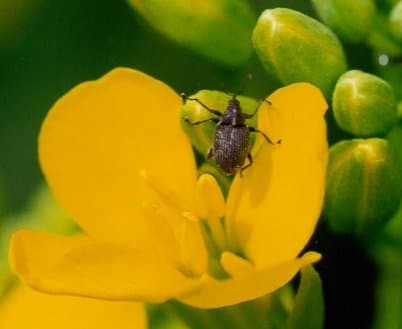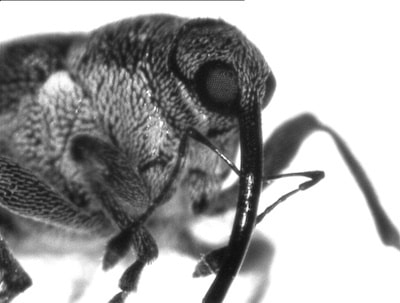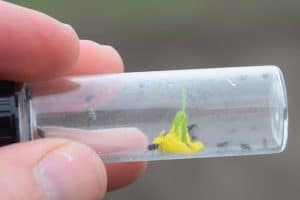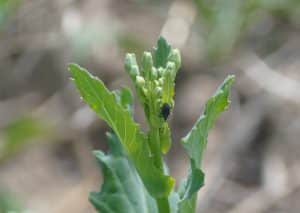Cabbage seedpod weevils will feed on buds, but spraying is rarely recommended before the canola crop reaches 10% flowering stage. Three reasons to wait for 10% flowering are:
- Economic loss from cabbage seedpod weevils (CSPW) is due almost entirely from weevils laying eggs in young pods. These eggs then hatch a couple weeks later, with larvae feeding on developing seeds.
- CSPW move very easily from field to field. Spraying weevils on buds on early canola fields will take out those particular weevils, but by early flowering — which is the critical control stage — a whole new group of weevils will be back. Not only could a second spray be required, but some insecticides cannot be sprayed twice in one season.
- Low levels of bud feeding can cause a defense response in healthy plants, causing them to flower longer, This can actually lead to an increase in yield when weather conditions in mid to late summer allow for good compensatory growth. This has been shown with early lygus feeding and the thinking could be extended to weevil feeding as well.




Scouting tips
Scout at 10-20% flower (or approximately one week after first flower) using a sweep net. The economic threshold is 25-40 CSPW per 10 sweeps generally across the field. Use proper sweep net technique and make ten 180° sweeps at each location.
New analysis from AAFC indicates that a minimum of 2 sets of 2 paired samples (4 sets in total with 10 sweeps per set) can provide a good assessment of weevil numbers. However, the two sets need be in different parts of the field. Do one set of 10 sweeps near the field edge and the next another 50 m into the field. Repeat this at the opposite end of the field or from a different field access point. Large difference in CSPW numbers between the 4 sample sets may indicate continued movement of CPSW into the field and the need for continued scouting.
Avoid spraying too soon as CSPW will continue to be attracted to fields coming into flower, and damage does not occur until the pods are large enough to support egg laying by the adult female. This would be when the oldest pod reaches 1″ in length.
Cabbage seedpod weevils enter a field from the side and work their way to the middle. Scouting borders of fields twice a week may allow you to catch their first arrival, possibly allowing adequate control with a perimeter spray of the outside edges of the field. Shelterbelts and fence lines are a good clue as to which side might be first. Also, continue to scout after application if relying on perimeter sprays (keeping in mind safe field re-entry times) in case re-invasion occurs.
If you are in a field with variable maturity, sweep randomly and don’t just favour flowering patches. You could easily find elevated numbers in the area that has started to flower, but when the field begins flowering more uniformly, the average number of weevils per sweep will decrease.
Note the possible weather effect: On days above 12°C with low to moderate wind, weevils will be concentrated in the top area of the crop. In these conditions, they are easy to pick up with a sweep net.
When to spray
The goal is to stop adults from laying eggs in newly formed pods. Cabbage seedpod weevils don’t lay eggs until pods are at least 3/4” long. First pods reach this size 4 to 5 days after first flower. This will be around 10% to 20% bloom. A few eggs laid in the first pods is better than spraying too early and not getting good control of higher CSPW populations that may move in.
Don’t spray too soon. Products registered for cabbage seedpod weevil can be sprayed only once per year, so correct timing is important. Also note that if a product has already been used on flea beetles, it may not be available for use again in that crop if the label permits only one use per crop per season.
Avoid peak sun. When you spray an insecticide, avoid peak sunshine hours of the day when bees and other beneficials will be most active in the field. Note that some of the common CSPW registered products are synthetic pyrethroids that can lose efficacy at higher temps. This is another reason to spray later in the day.
For earliest crops in the area
Earliest-flowering crops may attract more CSPW. Watch them closely. With enough adults feeding, it is possible to have the crop set back at the bud stage – especially a crop under stress or with plant counts below 5 per square foot.
Other considerations
The seed production exception. Commercial seed producers may want to spray cabbage seedpod weevil at the bud stage. This is not ideal, but they don’t want to spray flowering crop because they’ve paid a lot of money for pollinating bees and they don’t want to jeopardize this investment.
Tank mixing insecticide with fungicide. If the economic threshold is reached for CSPW and conditions also warrant a fungicide for sclerotinia stem rot management, holding out CSPW control until 20% bloom provides an opportunity to tank mix insecticide with the fungicide application. This is a little later than the ideal timing for CSPW but the earliest stage for fungicide labels.
CSPW and lygus. According to recent research by AAFC in Alberta, CSPW and lygus do not become pests in the same fields. Early planted fields with high CSPW have very low lygus populations. Thus, there is no economic return to spray for lygus at early flower in early seeded fields.
More…
Alberta Insect Pest Monitoring Network includes a form to report weevils here. See the real-time map showing count results.
What does 10%, 20% and 50% flower look like?
